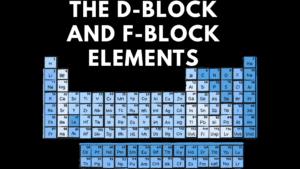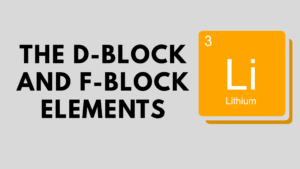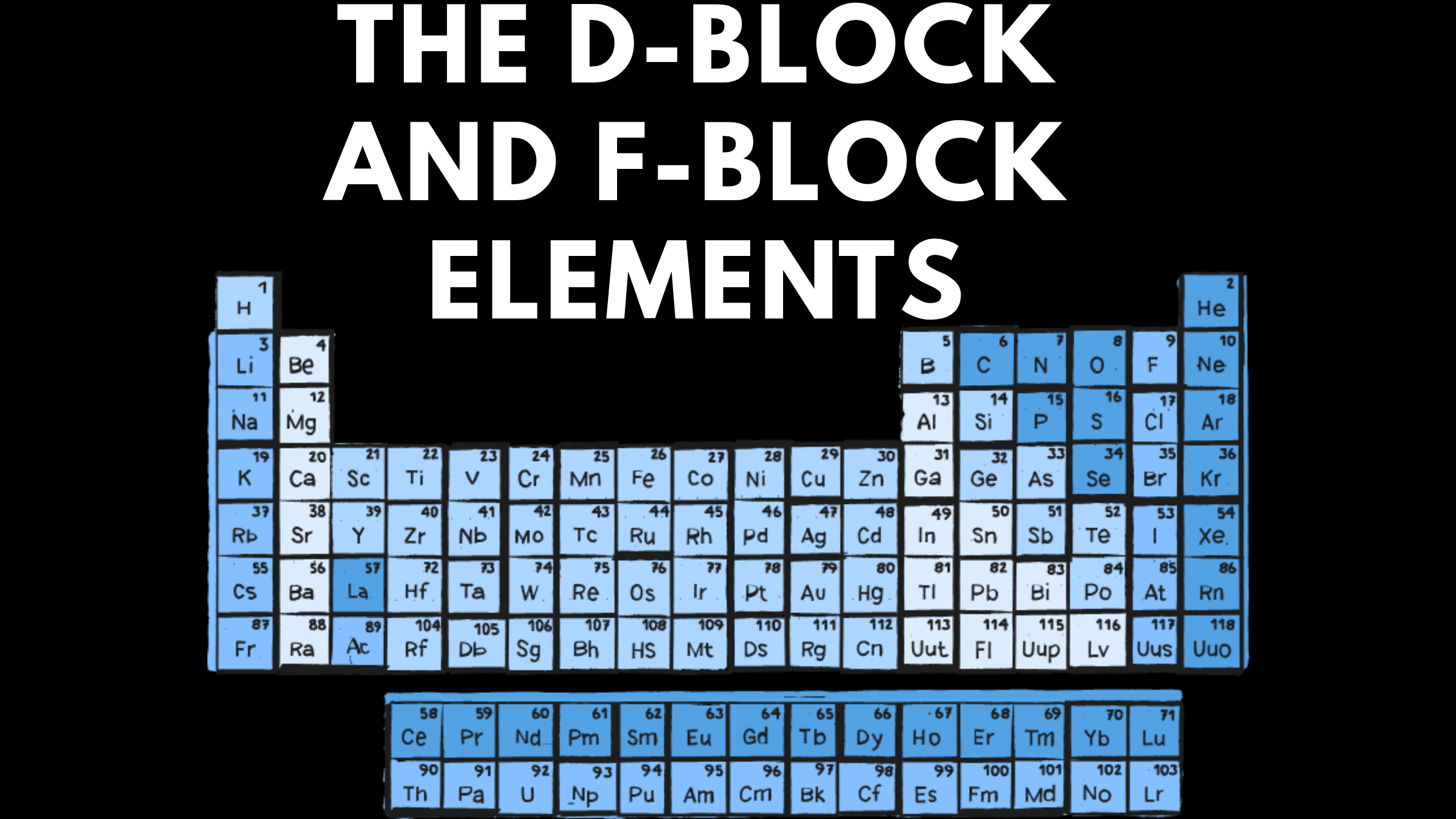In the periodic table, the d-block and f-block elements occupy a unique position due to their partially filled d and f orbitals, respectively. These elements exhibit variable oxidation states, form colored compounds, show magnetic properties, and play vital roles in industries, metallurgy, and biological systems.
In Class 12 Chemistry, studying these elements provides insights into transition metals, inner transition metals, their properties, and applications. This chapter is crucial for board exams, competitive exams like JEE, NEET, and for developing a deeper understanding of inorganic chemistry.

Class 12 Chemistry Notes: The d-Block and f-Block Elements | Complete Guide with Questions
The d-Block Elements (Transition Metals)
Position in the Periodic Table
-
The d-block elements are placed between the s-block and p-block elements in the periodic table.
-
They belong to groups 3 to 12.
-
The general electronic configuration: (n-1)d¹–¹⁰ ns¹–².
Characteristics of d-Block Elements
-
Metallic Character
-
All d-block elements are metals with high melting and boiling points.
-
Mercury (Hg) is an exception as it is liquid at room temperature.
-
-
Variable Oxidation States
-
Due to the participation of both ns and (n-1)d electrons in bonding.
-
Example: Manganese shows oxidation states from +2 to +7.
-
-
Formation of Colored Compounds
-
Color is due to d–d electronic transitions in partially filled d-orbitals.
-
Example: [Ti(H₂O)₆]³⁺ appears purple.
-
-
Paramagnetic Behavior
-
Due to unpaired d-electrons.
-
The more the unpaired electrons, the stronger the paramagnetism.
-
-
Catalytic Properties
-
Many transition metals act as catalysts because they can change oxidation states and provide a surface for reactions.
-
Example: V₂O₅ in the contact process for sulfuric acid.
-
-
Alloy Formation
-
d-block metals form alloys due to similar atomic sizes and crystal structures.
-
Example: Brass (Cu + Zn).
-
-
Formation of Complex Compounds
-
Transition metals form coordination compounds with ligands.
-
Example: [Fe(CN)₆]³⁻, [Cu(NH₃)₄]²⁺.
-
Important Series in d-Block
-
First Transition Series: 3d elements (Sc to Zn).
-
Second Transition Series: 4d elements (Y to Cd).
-
Third Transition Series: 5d elements (La, Hf to Hg).
-
Fourth Transition Series: 6d elements (still incomplete).
Trends in Properties of d-Block Elements
Atomic and Ionic Radii
-
Decrease across a period due to increased nuclear charge.
-
Show slight increase in the second and third series (lanthanide contraction).
Ionization Enthalpy
-
Increases across the period but irregular due to stability of half-filled and fully filled d-orbitals.
Metallic Properties
-
Exhibit metallic bonding, high density, strength, and conductivity.
Standard Electrode Potential
-
Varies irregularly due to complex factors like ionization enthalpy and enthalpy of atomization.
Important Compounds of Transition Metals
-
Potassium dichromate (K₂Cr₂O₇): Oxidizing agent, orange color.
-
Potassium permanganate (KMnO₄): Strong oxidizing agent, purple color.
The f-Block Elements (Inner Transition Metals)

Position in the Periodic Table
-
The f-block elements are placed separately at the bottom of the periodic table.
-
They consist of lanthanides (4f) and actinides (5f).
-
General electronic configuration: (n-2)f¹–¹⁴ (n-1)d⁰–¹ ns².
The Lanthanides (4f-Series)
Characteristics
-
Atomic and Ionic Radii
-
Show lanthanide contraction: steady decrease in size across the series.
-
-
Oxidation States
-
Mostly +3 oxidation state is stable.
-
-
Magnetic Properties
-
Paramagnetic due to unpaired 4f electrons.
-
-
Spectral Properties
-
Many are colored due to f–f transitions.
-
-
Complex Formation
-
Poor tendency to form complexes due to larger ionic size.
-
Uses of Lanthanides
-
Europium: Red phosphor in TV screens.
-
Cerium: In alloys for lighter flints.
-
Lanthanum: In optical glasses.
The Actinides (5f-Series)
Characteristics
-
Radioactive Nature
-
All actinides are radioactive.
-
Example: Uranium, Thorium, Plutonium.
-
-
Oxidation States
-
Show variable oxidation states from +3 to +6.
-
-
Magnetic and Spectral Properties
-
Similar to lanthanides but more complex due to 5f orbitals.
-
-
Actinide Contraction
-
Similar to lanthanide contraction but less prominent.
-
Uses of Actinides
-
Uranium-235: Nuclear fuel.
-
Plutonium-239: Atomic energy and weapons.
-
Thorium: Used in nuclear reactors.
Comparison Between the d-Block and f-Block Elements
| Property | d-Block Elements | f-Block Elements |
|---|---|---|
| Position | Groups 3–12 | Separate block |
| Orbitals Involved | (n-1)d | (n-2)f |
| Oxidation States | Variable | Mostly +3 (Lanthanides) |
| Magnetic Properties | Paramagnetic | Strongly paramagnetic |
| Examples | Fe, Cu, Zn | Ce, U, Th |
Applications of the d-Block and f-Block Elements
-
Catalysts: V₂O₅, Pt in industrial processes.
-
Alloys: Steel, stainless steel, brass.
-
Nuclear Energy: Uranium, Thorium, Plutonium.
-
Electronic Devices: Rare-earth elements in magnets, lasers.
-
Medical Field: Radioactive isotopes in cancer treatment.
Objective Questions on The d-Block and f-Block Elements
Q1. Which of the following is not a d-block element?
a) Iron (Fe)
b) Copper (Cu)
c) Zinc (Zn)
d) Calcium (Ca)
Answer: Calcium
Explanation:
The d-block elements are transition metals placed in groups 3–12 of the periodic table. Calcium belongs to group 2 (s-block), hence it is not a d-block element.
Q2. The general electronic configuration of d-block elements is:
a) (n-1)d¹–¹⁰ ns¹–²
b) ns² np¹–⁶
c) (n-2)f¹–¹⁴ (n-1)d⁰–¹ ns²
d) ns¹
Answer: (n-1)d¹–¹⁰ ns¹–²
Explanation:
The d-block elements have partially filled d-orbitals in their penultimate shell. Their general configuration is (n-1)d¹–¹⁰ ns¹–², explaining their variable oxidation states and metallic properties.
Q3. Which transition metal is liquid at room temperature?
a) Iron
b) Mercury
c) Zinc
d) Copper
Answer: Mercury
Explanation:
All transition metals are solid at room temperature except mercury (Hg), which is liquid due to its weak metallic bonding arising from its electronic configuration.
Q4. The color of transition metal compounds is mainly due to:
a) d–d electronic transitions
b) s–p transitions
c) Charge transfer only
d) Nuclear transitions
Answer: d–d electronic transitions
Explanation:
Transition metals have partially filled d-orbitals. When visible light excites an electron from a lower to a higher d-orbital, the compound absorbs certain wavelengths, leading to characteristic colors.
Q5. Which element shows the maximum number of oxidation states?
a) Chromium
b) Manganese
c) Iron
d) Cobalt
Answer: Manganese
Explanation:
Manganese (Mn) shows oxidation states from +2 to +7 because it has multiple d and s electrons available for bonding, making it unique among transition metals.
Q6. The actinides exhibit:
a) Only +3 oxidation state
b) Only +2 oxidation state
c) Variable oxidation states
d) No oxidation state
Answer: Variable oxidation states
Explanation:
Actinides show variable oxidation states from +3 to +6 due to the comparable energies of 5f, 6d, and 7s orbitals, allowing different numbers of electrons to participate in bonding.
Q7. Lanthanide contraction is due to:
a) Poor shielding of f-electrons
b) Strong nuclear charge
c) Both (a) and (b)
d) Large atomic size
Answer: Both (a) and (b)
Explanation:
Lanthanide contraction occurs because f-electrons shield nuclear charge poorly, so as atomic number increases, the effective nuclear charge increases, pulling electrons closer and reducing atomic radii.
Q8. Which compound is used as an oxidizing agent in acidic medium?
a) K₂Cr₂O₇
b) NaCl
c) Na₂SO₄
d) KCl
Answer: K₂Cr₂O₇
Explanation:
Potassium dichromate (K₂Cr₂O₇) in acidic medium acts as a powerful oxidizing agent because Cr⁶⁺ gets reduced to Cr³⁺ while oxidizing other substances.
Q9. The paramagnetic nature of transition metals is due to:
a) Unpaired s-electrons
b) Unpaired p-electrons
c) Unpaired d-electrons
d) No unpaired electrons
Answer: Unpaired d-electrons
Explanation:
Transition metals have unpaired electrons in d-orbitals, which give rise to paramagnetism due to the presence of a magnetic moment associated with electron spin.
Q10. Which of the following is not a property of transition metals?
a) Formation of colored ions
b) Variable oxidation states
c) Catalytic properties
d) Low melting point
Answer: Low melting point
Explanation:
Transition metals usually have high melting and boiling points due to strong metallic bonding. Low melting point is not a general property except for mercury.
Q11. Actinide contraction is similar to:
a) d-block contraction
b) Lanthanide contraction
c) Noble gas contraction
d) No contraction
Answer: Lanthanide contraction
Explanation:
Actinide contraction resembles lanthanide contraction because both involve poor shielding by f-electrons, leading to a decrease in atomic size across the series.
Q12. The only stable oxidation state of lanthanides is:
a) +1
b) +2
c) +3
d) +4
Answer: +3
Explanation:
Lanthanides predominantly show the +3 oxidation state because the loss of three outer electrons gives them a stable electronic configuration with empty 5d and 6s shells.
Q13. Which transition metal forms stainless steel with iron?

a) Copper
b) Nickel
c) Cobalt
d) Chromium
Answer: Chromium
Explanation:
Stainless steel is an alloy of iron with chromium and nickel. Chromium forms a protective oxide layer on the surface, making steel resistant to corrosion.
Q14. The 5f series of elements are called:
a) Lanthanides
b) Actinides
c) Transition metals
d) Noble metals
Answer: Actinides
Explanation:
The elements in which the last electron enters the 5f orbital are called actinides. They include elements from Thorium (Th) to Lawrencium (Lr).
Q15. Which lanthanide is used in making lighter flints?
a) Cerium
b) Neodymium
c) Europium
d) Samarium
Answer: Cerium
Explanation:
Cerium (Ce) forms an alloy called mischmetal used in lighter flints because it produces sparks when struck due to its pyrophoric nature.
Q16. The catalytic property of transition metals is due to:
a) High density
b) Variable oxidation states
c) Complex formation
d) Alloy formation
Answer: Variable oxidation states
Explanation:
Transition metals change oxidation states easily, providing a suitable surface for reactants and lowering the activation energy, making them efficient catalysts.
Q17. Which of the following is radioactive?
a) Uranium
b) Cerium
c) Iron
d) Zinc
Answer: Uranium
Explanation:
Uranium is an actinide element and all actinides are radioactive, with Uranium-235 being important as nuclear fuel in reactors.
Q18. The decrease in atomic size across lanthanide series is called:
a) Actinide contraction
b) Nuclear contraction
c) Lanthanide contraction
d) d-block contraction
Answer: Lanthanide contraction
Explanation:
The steady decrease in atomic size from Lanthanum (La) to Lutetium (Lu) is due to poor shielding of 4f electrons, known as lanthanide contraction.
Q19. Which of the following is a d-block element?
a) Sodium
b) Zinc
c) Helium
d) Lithium
Answer: Zinc
Explanation:
Zinc belongs to group 12 with electronic configuration [Ar]3d¹⁰4s² and is therefore classified as a d-block element, though it does not show variable oxidation states.
Q20. Potassium permanganate (KMnO₄) is used as:
a) Reducing agent
b) Oxidizing agent
c) Catalyst
d) Fuel
Answer: Oxidizing agent
Explanation:
KMnO₄ is a strong oxidizing agent in both acidic and neutral media because Mn⁷⁺ gets reduced to Mn²⁺ or Mn⁴⁺ while oxidizing other substances.
Short Answer Questions-The d-Block and f-Block Elements
Q1. Why do transition metals show variable oxidation states?
Answer:
Transition metals have variable oxidation states because they can lose both the outermost ns electrons and the inner (n-1)d electrons for bonding. The energies of these orbitals are very close, allowing different numbers of electrons to participate in chemical reactions, leading to multiple oxidation states.
Q2. What is lanthanide contraction and what are its consequences?
Answer:
Lanthanide contraction refers to the steady decrease in the atomic and ionic radii of lanthanide elements from Lanthanum (La) to Lutetium (Lu). This happens because the 4f electrons poorly shield the nuclear charge, causing increased attraction between the nucleus and electrons. Consequences include:
-
Similar chemical properties of lanthanides.
-
Increased basicity of hydroxides from La(OH)₃ to Lu(OH)₃.
-
Difficulty in separating lanthanides due to similar sizes.
Q3. Why are transition metal complexes often colored?
Answer:
Transition metal complexes are colored due to d–d electronic transitions. When visible light falls on the complex, electrons in the lower-energy d-orbitals absorb certain wavelengths of light and jump to higher-energy d-orbitals. The remaining wavelengths of light that are transmitted or reflected give the complex its characteristic color.
Q4. Why do actinides show greater variability in oxidation states than lanthanides?
Answer:
Actinides show greater variability in oxidation states because they have 5f, 6d, and 7s orbitals with comparable energies. As a result, different numbers of electrons can participate in bonding. In contrast, lanthanides mainly involve 4f and 6s electrons, leading to fewer oxidation states, mostly +3.
Q5. Name two important uses of potassium dichromate (K₂Cr₂O₇).
Answer:
Potassium dichromate is a strong oxidizing agent used for:
-
Oxidation of alcohols to aldehydes or ketones in laboratories.
-
In tanning leather, dyeing fabrics, and as a primary standard in volumetric analysis.
Long Answer Questions-The d-Block and f-Block Elements
Q6. Explain the trends in atomic and ionic radii of d-block elements across a period.
Answer:
Across a d-block series, the atomic and ionic radii generally decrease from left to right because of an increase in nuclear charge while electrons are being added to the same shell. The increasing nuclear charge pulls the electrons closer to the nucleus, reducing the size. However, after the middle of the series, the addition of electrons in d-orbitals causes electron-electron repulsion, so the decrease in size becomes less significant, leading to almost constant radii in later elements.
Q7. Discuss the magnetic properties of transition metals with examples.
Answer:
The magnetic properties of transition metals arise from the presence of unpaired d-electrons. The magnetic moment (μ) is given by the formula:
μ = √n(n+2) BM (Bohr Magneton), where n = number of unpaired electrons.
-
Metals with unpaired electrons exhibit paramagnetism (attracted by a magnetic field). Example: Mn²⁺ with five unpaired electrons shows strong paramagnetism.
-
Metals with all electrons paired are diamagnetic (weakly repelled by a magnetic field). Example: Zn²⁺ with no unpaired electrons is diamagnetic.
Q8. Write a note on the catalytic properties of transition metals.
Answer:
Transition metals act as catalysts because they can change oxidation states easily and provide a surface for reactions. Their partially filled d-orbitals allow them to form temporary bonds with reactants, lowering the activation energy. Examples include:
-
V₂O₅ as a catalyst in the Contact Process for the manufacture of H₂SO₄.
-
Fe in the Haber Process for ammonia synthesis.
-
Ni in hydrogenation of oils.
Q9. Compare the properties of lanthanides and actinides.
Answer:
-
Lanthanides (4f series): Mostly exhibit +3 oxidation state, less complex chemistry, and are non-radioactive except promethium. They show lanthanide contraction leading to similar chemical properties.
-
Actinides (5f series): Exhibit multiple oxidation states (+3 to +6), are all radioactive, and show actinide contraction. Their chemistry is more complex due to variable oxidation states and radioactive decay.
Thus, while both show contraction and f-electron characteristics, actinides have higher radioactivity and oxidation state variability.
Q10. Describe the industrial importance of the d-block and f-block elements.
Answer:
-
d-Block Elements:
-
Iron: In construction (steel).
-
Titanium: In aerospace industry due to high strength-to-weight ratio.
-
Platinum and Palladium: Catalysts in chemical industries.
-
-
f-Block Elements:
-
Uranium-235 and Plutonium-239: Nuclear fuels for power generation.
-
Thorium: Used in nuclear reactors.
-
Lanthanides: In optical glasses, phosphors for TV screens, and powerful magnets.
-
Their wide applications in energy, construction, and technology highlight their industrial significance.
Conclusion
The d-block and f-block elements hold significant importance in chemistry due to their unique properties like variable oxidation states, catalytic activity, formation of colored compounds, and magnetic behavior. Understanding their characteristics, trends, and applications not only helps in academic exams but also builds a foundation for industrial and research purposes.
Electrostatics Class 12 Chemistry Notes | Complete Guide with MCQs
